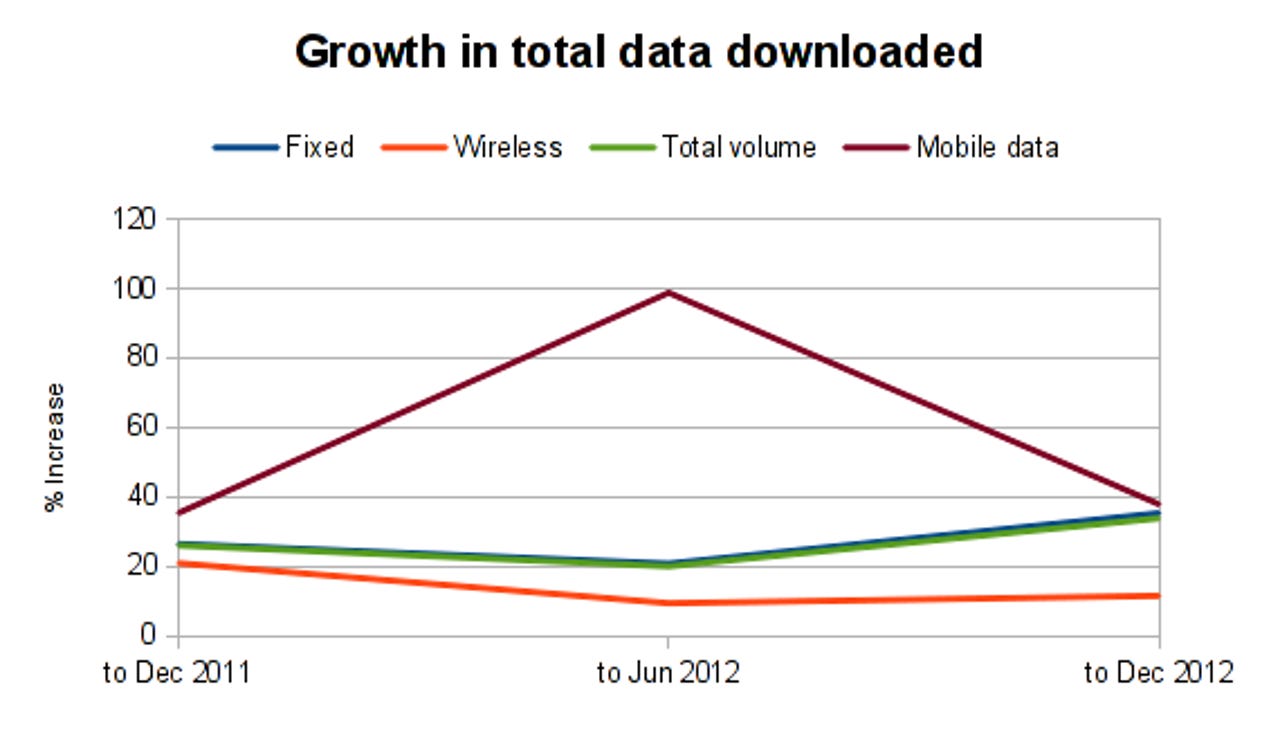Dear Mr Broadband, where is that wireless revolution we were promised?

In the six months since the last release of the Australian Bureau of Statistics' (ABS) Internet Activity report, we've seen the launch of a popular 4G phone in the form of the iPhone 5, Australian telcos are expanding their long-term evolution (LTE) networks, and the copper that most of us rely on for our broadband has rotted a little further.
If ever the conditions for a takeoff of mobile data consumption were ripe, it was this six-month period.
In the latest release of the Internet Activity report, the headline figure is a 38 percent increase in the amount of data downloaded via mobile handsets to an estimated 13,703 Terabytes (TB).
This compares to the newly revised figure from the previous report for the half year to June 2012, which saw mobile downloads increase by 99 percent.
It is worth noting that the mobile download number only counts revenue-generating downloads — data from free-to-stream music services, for instance, are not counted in this total.
On the fixed-line side of the broadband equation, growth in the amount of data downloaded increased from 21 percent in June 2012 to 35 percent growth in the past six months, giving a final number of the amount of data downloaded by fixed-line broadband to 526,472TB.
That makes fixed-line broadband responsible for 95 percent of the data downloaded by Australians in the past six months — up a single percentage point since June 2012.
After a new Apple phone with LTE capability, increased 4G coverage, and the fact that LTE is multiples quicker than many ADSL connections presently in use, fixed-line broadband actually increased its percentage of total data downloaded.
In terms of the speeds of fixed subscriber lines, for the first time, there are more subscribers in the 8Mbps to 24Mbps band than any other, coming in at 5.4 million, an increase of 32 percent in six months. The previous band with the highest subscriber base was the 1.5Mbps to 8Mbps band; it now sits at 4.2 million, down from 5.1 million subscribers in the previous report. The slowest broadband speed in the report, 256Kbps to 1.5Mbps, saw its subscriber number fall from 980,000 to 609,000. Dial-up internet access suffered a major loss of subscribers, falling from 439,000 subscribers to 282,000 subscribers.
The highest speed band of greater than 24Mbps saw its subscriber base increase by 13 percent to 1.65 million subscribers.
Be aware, though, that these speeds are "advertised speeds" and do not reflect the variables of Australian broadband life, such as flooded ducts and line degradation.
Regardless of which party rolls out the National Broadband Network (NBN) in the coming years, the speeds of fixed-line broadband are only going to increase and possibly eclipse LTE and its next-gen wireless brethren.
Yet, take to the AM band in Sydney, and you'll hear commentary that decries fibre as a "white elephant" and mobile wireless as the future for all things digital.
"We are rolling out cable at incredible expense, when the future is clearly wireless," noted NBN critic Alan Jones said on Thursday before introducing Shadow Communications Malcolm Turnbull. (The quote is at 5:45 in the recording.)
And how did Turnbull, the Liberal Party's internet pioneer and newly dubbed "Mr Broadband", welcome the comments made by Jones?
"Well, Alan, I have to agree with everything you've said there," said Turnbull. "It is a very, very sorry — all you've done is state the facts."
It's tempting to give Turnbull the benefit of the doubt, and say that he wasn't agreeing directly with Jones. But when a shadow minister poses with a tablet as an example of "how fast broadband helps customers stream sport to iPads" after an alternative NBN policy launch, it raises concerns that maybe he does believe wireless is the future.
And why wouldn't the Liberal Party believe this? After all, its leader said on Tuesday that broadband running at 25Mbps would be "more than enough" for Australians — that speed falls squarely in the LTE download range. The caveat with LTE speeds, like any wireless solution, is that it is a wonderful and speedy option, but only if the network is not saturated with users.
The problem with thinking wireless is the future is that the numbers disagree thus far, there's been ample opportunity for wireless to make inroads into fixed-line broadband, and there's little sign of Australian broadband users changing their behaviour.
In fact, we are dropping away from the slowest offered fixed-line broadband speeds in increasing numbers.
Twelve months ago, it was fair to say that Australia was a country where the majority of internet connection speeds were below 8Mbps. Just a year later, the scales have shifted, and we are now a country with a majority connection speed of greater than 8Mbps.
Given these trends, what is the likelihood that Australians in 2019 will find the Coalition's 25Mbps acceptable?
In 2013, over 1.6 million subscribers are already beyond the Coalition's minimum speed, and this number is only going to increase as we head toward 2019.
